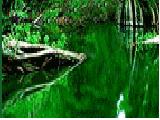Sajama
National Park is situated in the
southwestern part of Oruro Department in
the Province of Sajama. It borders on
the Department of La Paz to the north
and Chile’s Lauca National Park to the
west.
The park enjoys an annual average
temperature of 10 °C (50 °F), with a
low in winter of –30 °C (-22 °F) and
a daytime high of 22 °C (71.6 °F).
There is frost throughout the year and a
rainy season in the summer. The rivers
in the area belong to the inward flowing
high plateau river system dominated by
the Sajama, Tomarapi and Esquillani
Rivers.
Important volcanic cones, like Mount
Sajama and the Payachatas are located in
the park, together with several lagoons
and high lying Andean marshes, where
hardy and silicified grasses and a
variety of rosette-shaped plants are to
be found.
Access
The Park can be easily reached by taking
the new paved Patacamaya -Tambo Quemado
highway that links up La Paz, Oruro with
Arica, Chile.
Other possible routes are:
1. La Paz - Patacamaya- Lagunas -
Sajama.
2. Oruro - Toledo - Jankocala - Turco -
Cosapa -Sajama.
3. La Paz - Corocoro - Calacoto - Charaña
- Sepulturas - Sajama.
Tourist attractions
Imposing Mt. Sajama gives this national
park an exceptional natural beauty.
Other attractions include high lying
Andean lagoons, thermal springs and
coveted mountain climbing trails. The
queñua forests are of particular
scientific interest because of their
unique location at this altitude. Its
natural high mountain features make the
site a fascinating one.
Plant life
The area is known for its queñua
(Polylepis tarapacana) forests, which
climb above 5,200 masl, making them the
world’s highest lying woody formation.
Also noteworthy are the marshes with
their large pulvínulos or clumps of
yareta and wet grasslands and
Parastrephia lepidophylla
tholares(?)-The most important plants
are queñua and yareta (Azorella
compacta), both of which are endangered
species in the Andean subregion.
Animal life
Andean fauna is plentiful, particularly
vicuñas (Vicugna vicugna), quirquinchos
(Chaetophractus nationi), Andean cats or
titi (Felis jacobita), pumas (Felis
concolor), and large birds like the
ostrich (Pterocnemia pennata) and the
chocka (Fulica gigantea), together with
a wide variety of small birds.
This is an appropriate region for the
implementation of conservation,
endangered species recovery and vicuña
management programs. Wildlife management
constitutes an important alternative for
improving the living conditions of local
inhabitants. The area is an significant
reservoir of genetic species,
particularly those relating to alpaca
breeding and selection.
Population
The people populating the area belong to
the Aymará culture and are among those
who best conserve their traditional
social organization, customs and
mythical-religious beliefs, etc. Over
300 families are believed to live in the
park’s area of influence and nearly
100 within its boundaries. Almost all of
these dwellers make their living from
animal husbandry, particularly alpaca
breeding and fabric spinning and
weaving.
Archeology
Within the area are archeological and
historical sites of great cultural
value, like the Chullperios or
necropolises, pictographs and
pre-Columbian ruins. Colonial churches
with noteworthy features are also to be
found there.
|

![]() World
News World
Top Stories Web
Search Web
Images
Search Web
Groups Search Web
Catalogs Web
Directory
News Search
World
News World
Top Stories Web
Search Web
Images
Search Web
Groups Search Web
Catalogs Web
Directory
News Search






